 |
|
|
|
Bodega Bay Heritage Gallery Monthly |
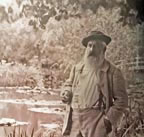 Claude Monet: The Truth of Nature Denver Art Museum through Feb 2 |
|
Serving clients by appointment In Northern California and beyond, in Bodega Bay, Graton, in your home, or online. |
|||
| Claude Monet; The Truth of Nature | |
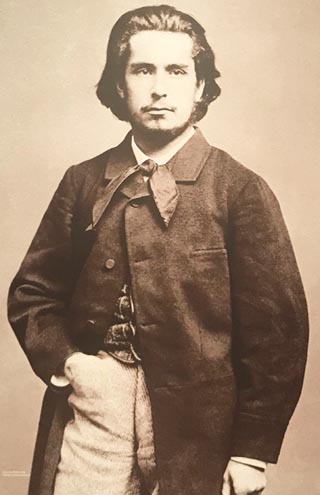 Claude Monet in 1860 at age 20 |
|
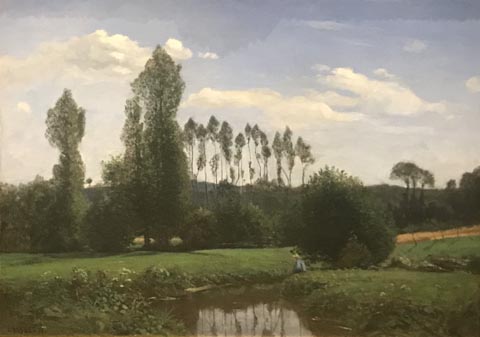 Claude Monet, View from Rouelles, 1858 Marunuma Art Park, Asaka, Japan |
|
|
 Claude Monet by his lily pond, 1905, age 65 |
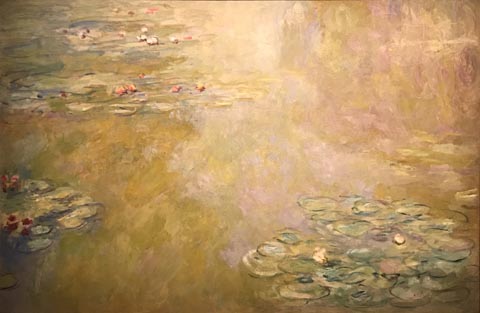 Claude Monet, Water-Lily Pond, c1918 Private Collection |
|
| Beginnings; Normandy and the Forest of Fontainebleau ... paintings from 1862 - 1873 | |
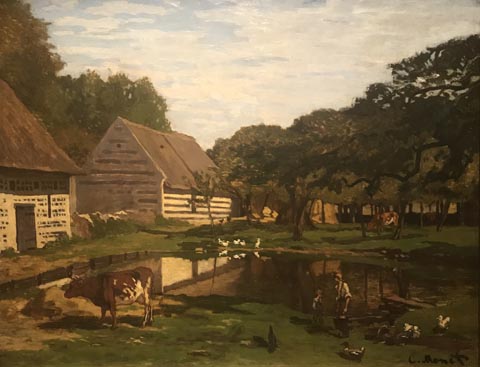 Claude Monet, Farmyard in Normandy, 1862-63 Musee d'Orsay, Paris, France |
|
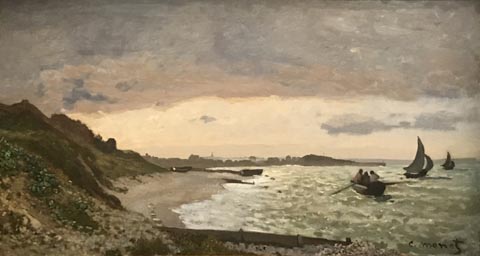 Claude Monet, The Seashore at Sainte-Adresse, 1864 Minneapolis Institute of Art, Minneapolis, MN |
|
|
|
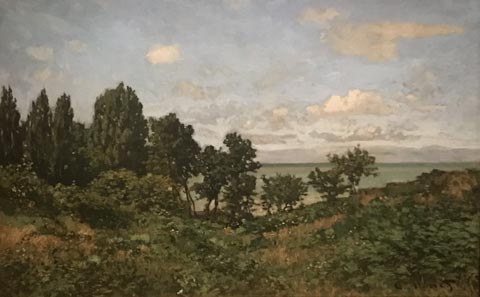 Claude Monet, Coastal Landscape, c1864 Van Gogh Museum, Amsterdam, The Netherlands |
 Claude Monet, La Pointe de La Heve at Low Tide, 1865 Kimbell Art Museum, Fort Worth, TX |
|
|
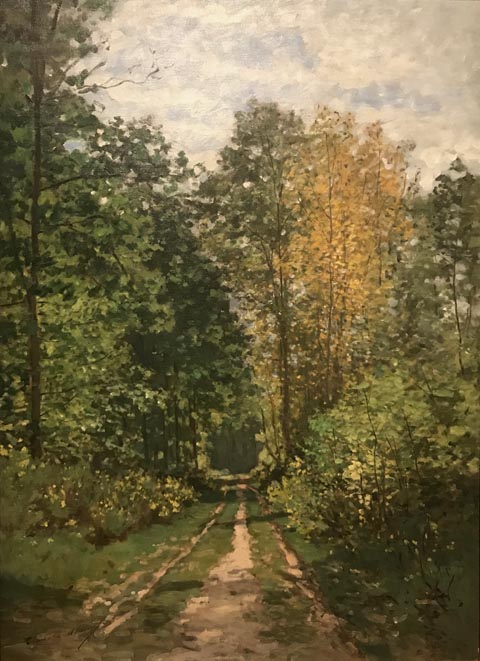 Claude Monet, Path into the Forest, 1865 Arp Museum Bahnhof Rolandseck, Remagen, Germany |
 Claude Monet, Haystacks at Chailly, 1865 San Diego Museum of Art, San Diego, CA |
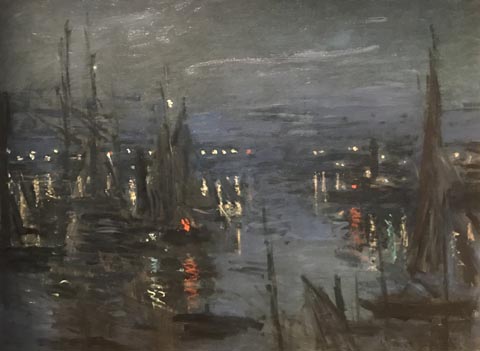 Claude Monet, The Port of Le Havre, Night Effect, 1873 Private Collection |
|
| Modern Life; Paris and its Surroundings ... paintings from 1870 ... 1878 | |
|
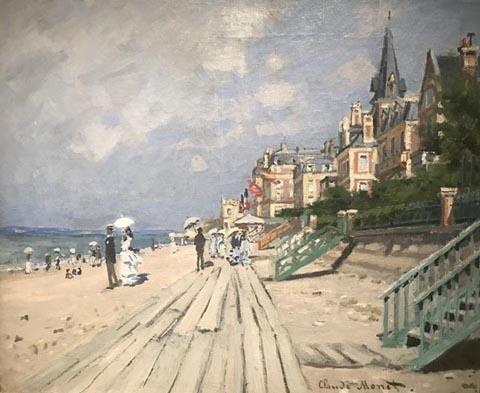 Claude Monet, The Beach at Trouville, 1870 Wadsworth Atheneum Museum of Art, Hartford, CT |
 Claude Monet, The Pont-Neuf, 1871 Dallas Museum of Art, Dallas, TX |
 Claude Monet, Boulevard des Capucines, 1873-74 The Nelson-Atkins Museum of Art, Kansas City, MO |
|
|
|
|
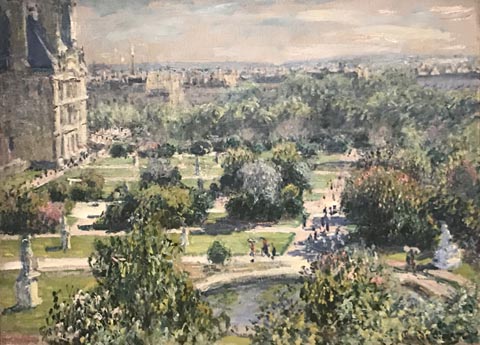 Claude Monet, The Tuileries, 1876 Musee Marmottan, Paris, France |
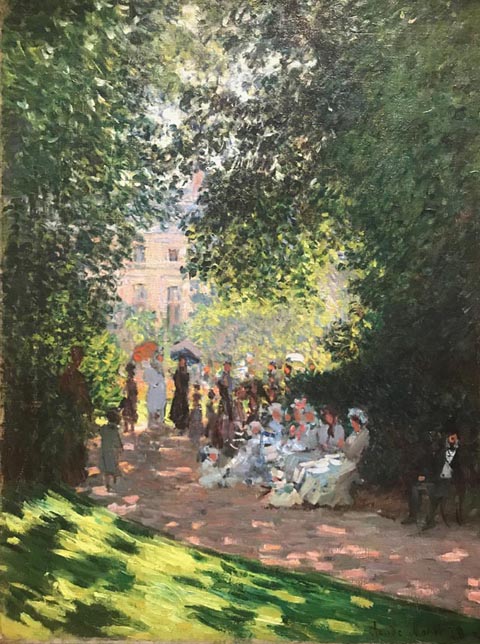 Claude Monet, The Parc Monceau, 1878 The Metropolitan Museum of Art, New York, NY |
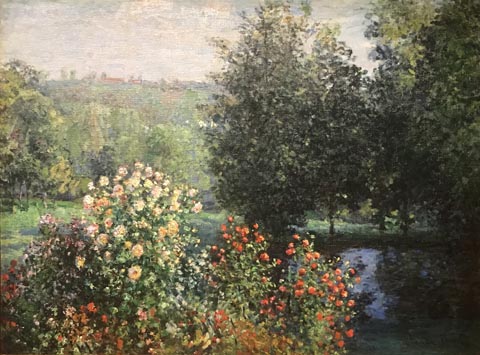 Claude Monet, The Rose Bushes in the Garden at Montgeron, 1876 Private Collection |
|
| Escape; The Netherlands | |
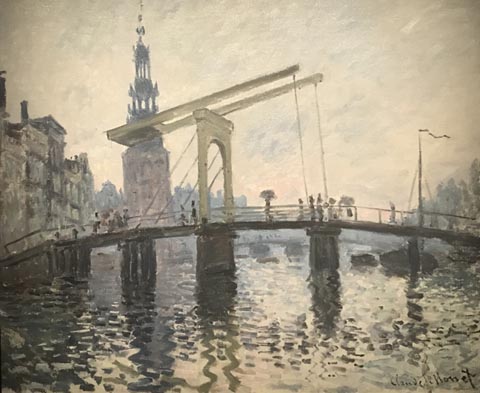 Claude Monet, The Drawbridge, Amsterdam, 1870-71 Shelburne Museum, Shelburn, VT |
|
 Boats of Zaandam, 1871 Private Collection |
|
|
|
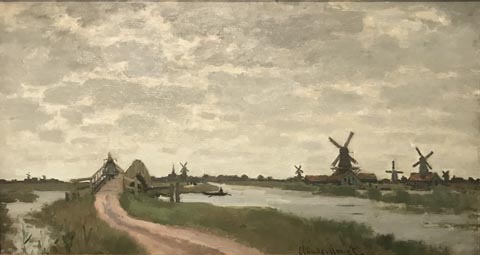 Claude Monet, Windmills near Zaandam, 1871 The Walters Art Museum, Baltimore, MD |
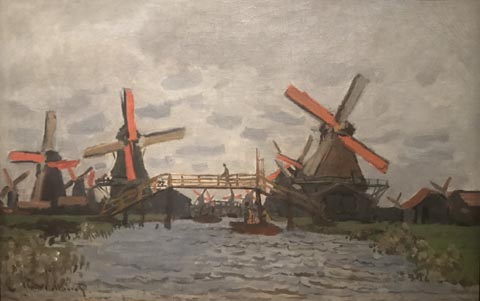 Claude Monet, Windmills near Zaandam, 1871 Van Gogh Museum, Amsterdam, The Netherlands |
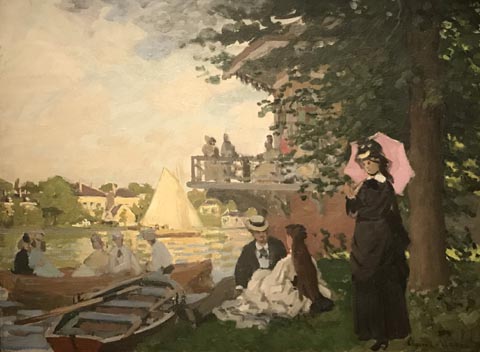 Claude Monet, The Landing Stage, 1871 Private Collection |
|
 Claude Monet, Tulip Fields at Sassenheim, 1886 Sterling and Francine Clark Art Institute, Williamstown, MA |
|
| Settling In; Argenteuil ... paintings from 1872 - 1875 | |
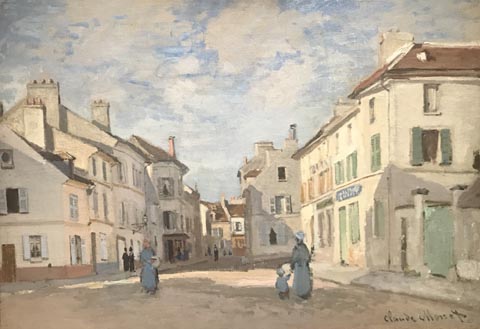 Claude Monet, The Old Rue de la Chaussee at Argenteuil, 1872 Christie's |
 Claude Monet, Argenteuil, Late Afternoon, 1872 Private Collection |
|
|
 Claude Monet, Argenteuil, c1872 National Gallery of Art, Washington, DC |
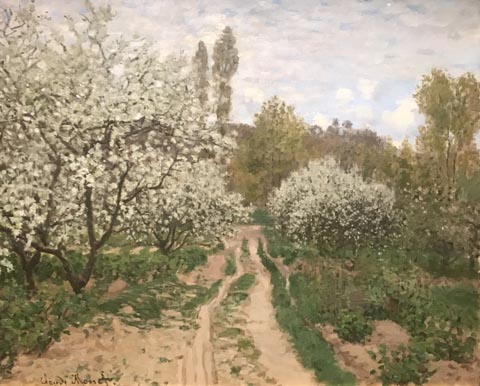 Claude Monet, Apple Trees in Blossom, 1872 Union League Club of Chicago, Chicago, IL |
 Claude Monet, Autumn on the Seine, Argenteuil, 1873 High Museum of Art, Atlanta, GA |
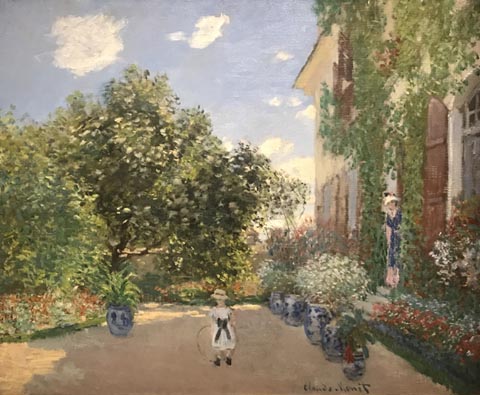 Claude Monet, The Artist's House at Argenteuil, 1873 The Art Institute of Chicago, Chicago, IL |
|
|
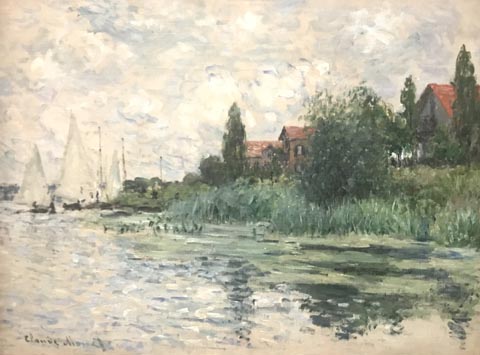 Claude Monet, The Banks of the Seine at Petit-Gennevilliers, 1874 John and Marine van Vlissingen Art Foundation, Zeist, The Netherlands |
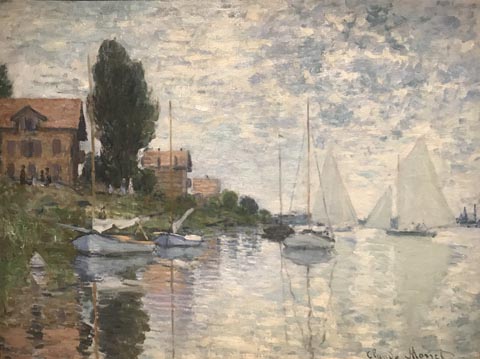 Claude Monet, At Le Petit-Gennevilliers, c1874 Private Collection, Asia |
|
|
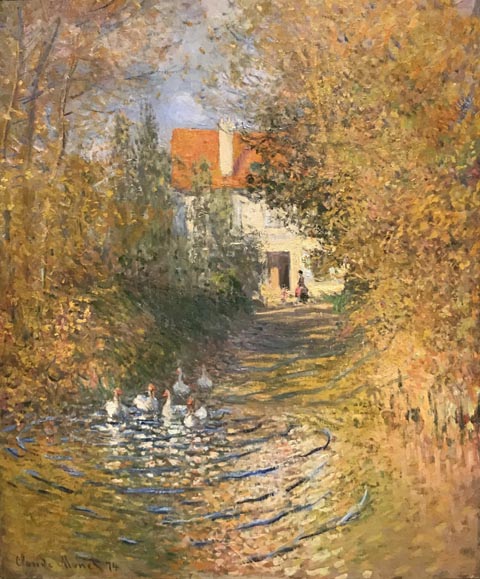 Claude Monet, The Geese, 1874 Sterling and Francine Clark Art Institute, Williamstown, MA |
 Claude Monet, The Geese (close-up excerpt), 1874 Sterling and Francine Clark Art Institute, Williamstown, MA |
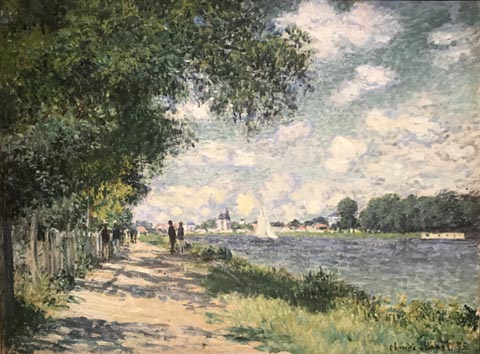 Claude Monet, The Seine at Argenteuil, 1875 Private Collection |
|
| Pure Landscapes, Vetheuil | |
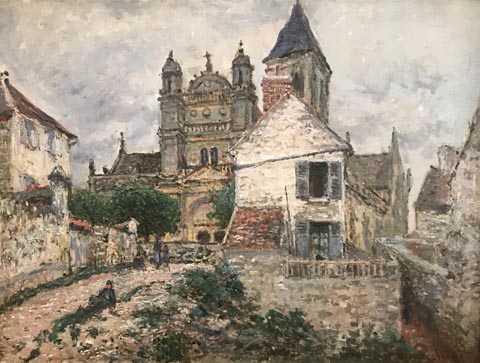 Claude Monet, The Church at Vetheuil, 1878 Halcyon Gallery, London, United Kingdom |
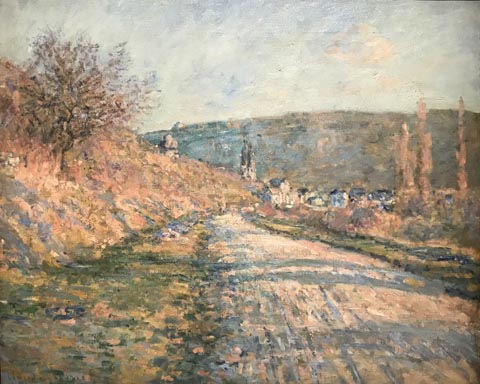 Claude Monet, The Road to Vetheuil, 1879 The Phillips Collection, Washington, DC |
|
|
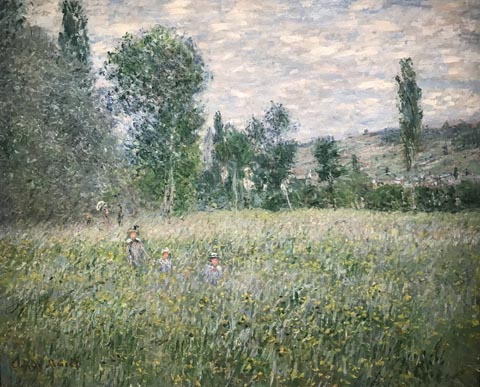 Claude Monet, The Meadow at Vetheuil, 1879 Joslyn Art Museum, Omaha, NE |
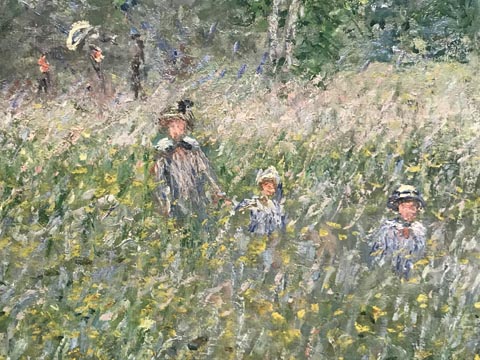 Claude Monet, The Meadow at Vetheuil (close-up), 1879 Joslyn Art Museum, Omaha, NE |
|
|
 Claude Monet, Banks of the Seine at Lavacourt, 1879 Frick Art and Historical Center, Pittsburgh, PA |
 Claude Monet, Vetheuil in Summer, 1879 Art Gallery of Ontario, Toronto, Ontario, Canada |
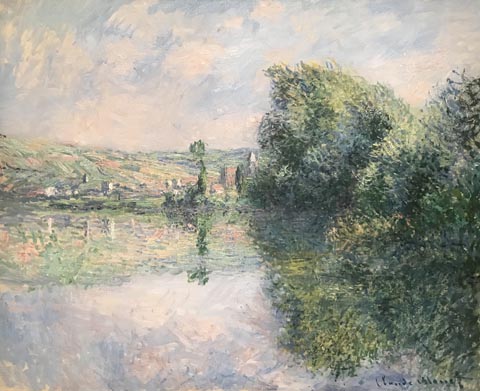 Claude Monet, The Seine at Vetheuil, c1880 Portland Museum of Art, Portland, ME |
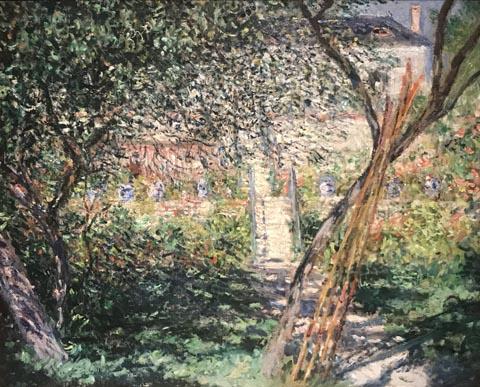 Claude Monet, The Garden at Vetheuil, 1881 Private Collection |
 Claude Monet, Wheat Field, 1881 Private Collection |
 Claude Monet, Landscape in the Ile Saint-Martin, 1881 Private Collection |
|
|
|
|
| In Winter; France and Norway ... paintings from 1875 - 1899 | |
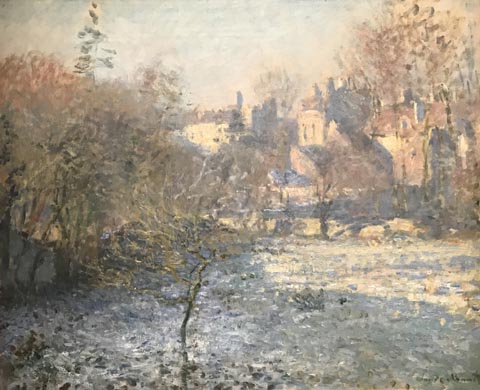 Claude Monet, Frost, 1875 Private Collection |
|
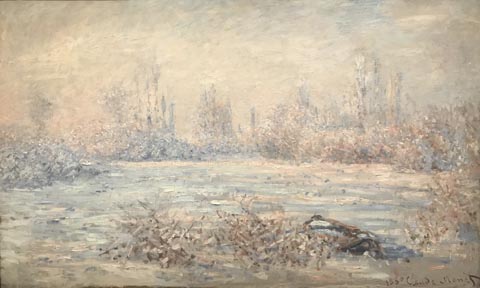 Claude Monet, Frost, 1880 Musee d'Orsay, Paris, France |
|
|
|
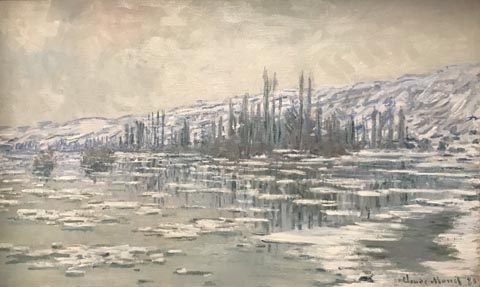 Claude Monet, The Break-up of the Ice, 1880 University of Michigan Museum of Art, Ann Arbor, MI |
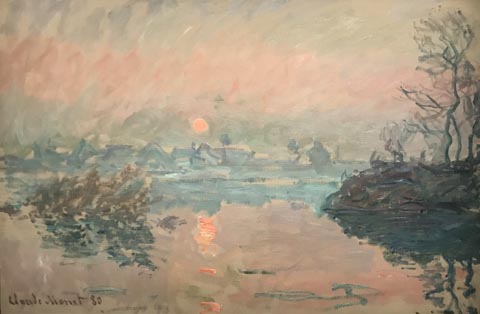 Claude Monet, Sunset at Lavacourt, 1880 Private Collection |
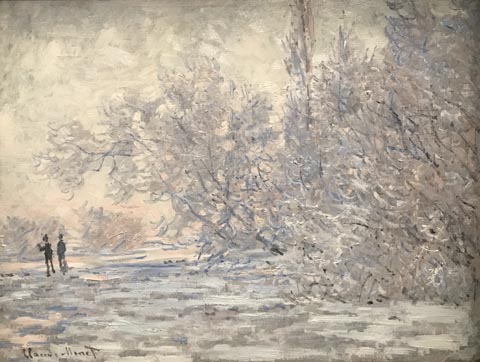 Claude Monet, Frost at Giverny, 1885 Private Collection |
 Claude Monet, Coming into Giverny in Winter, 1885 Private Collection |
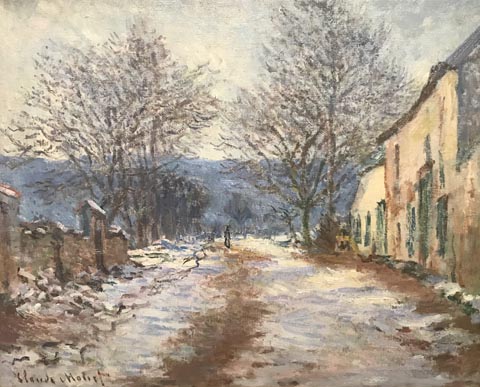 Claude Monet, Snow Effect at Limetz, 1886 Private Collection |
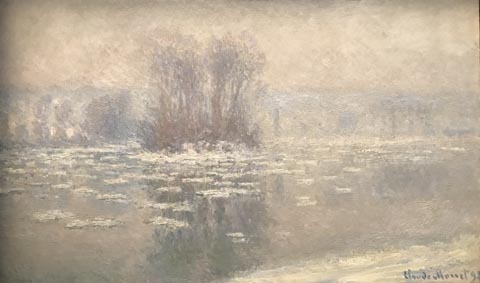 Claude Monet, Floating Ice in Bennecourt, 1893 Private Collection |
|
|
 Claude Monet, The Houses in the Snow, Norway, 1895 Denver Art Museum, Denver, CO |
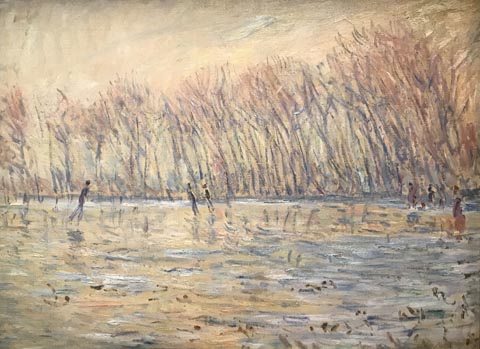 Claude Monet, Skaters at Giverny, 1899 Private Collection |
| Rocky Sea and Sky; Northern Coasts ... paintings from 1881 - 1897 | |
 Claude Monet, Boat Lying at Low Tide, 1881 Tokyo Fuji Art Museum, Tokyo, Japan |
 Claude Monet, The Beach at Fecamp, 1881 Private Collection |
|
|
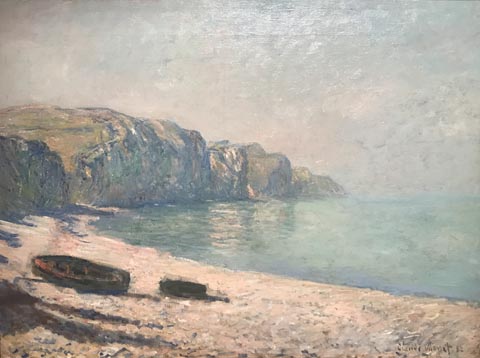 Claude Monet, Boats on the Beach at Pourville, Low Tide, 1882 The Kreeger Museum, Washington, DC |
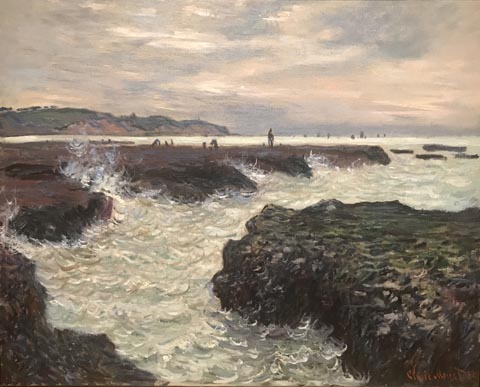 Claude Monet, The Rocks at Pourville, Low Tide, 1882 Memorial Art Gallery of the University of Rochester, Rochester, NY |
 Claude Monet, House of the Customs Officer, Varengeville, 1882 Harvard Art Museums, Fogg Museum, Cambridge, MA |
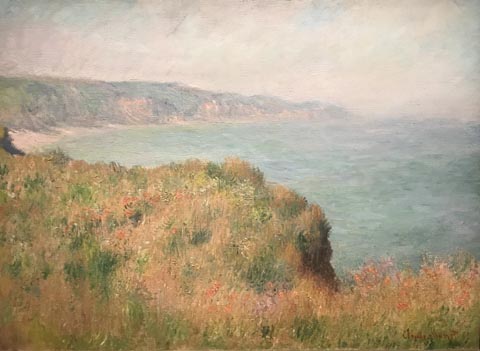 Claude Monet, Edge of the Cliff at Pourville, 1882 Private Collection |
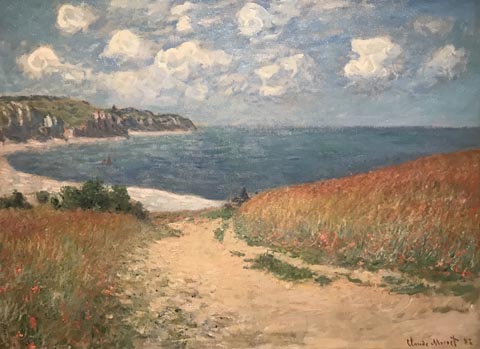 Claude Monet, Path in the Wheat Fields at Pourville, 1882 Denver Art Museum, Denver, CO |
 Claude Monet, The Cliff, Etretat, Sunset, 1882-83 North Carolina Museum of Art, Raleigh, NC |
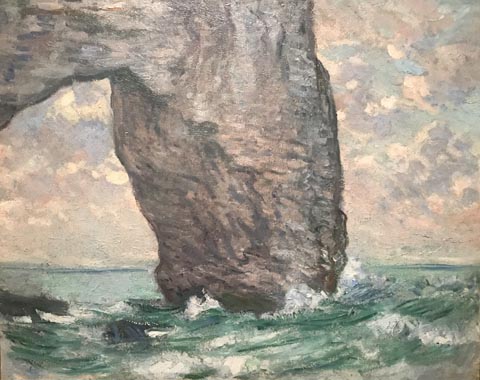 Claude Monet, The Manneporte Seen from the East, 1883 Isabelle and Scott Black Collection, displayed at a variety of museums, Including the Portland Museum of Art, Portland, OR and the Museum of Fine Arts, Boston, MA |
 Claude Monet, Fishing Boats, 1883 Denver Art Museum, Denver, CO |
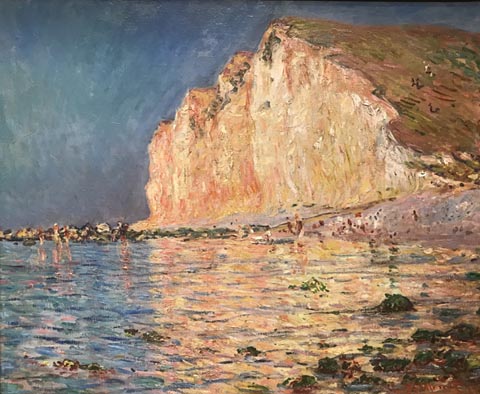 Claude Monet, Low Tide at Les Petites-Dalles, 1884 Private Collection |
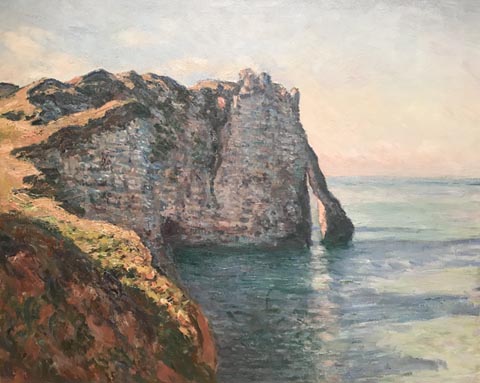 Claude Monet, Etretat, the Cliff and the Porte d'Aval, 1885 Private Collection |
 Claude Moneet, Fishing Boats at Etretat, 1885 Seattle Art Museum, Seattle, WA |
 Claude Monet, The Rock Needle Seen through the Porte d'Aval, 1885-86 Private Collectrion |
|
|
|
 Claude Monet, Rocks at Belle-Ile, Port Domois, 1886 Cincinnati Art Museum, Cincinnati, OH |
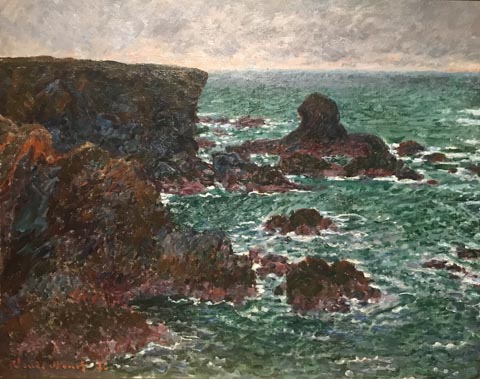 Claude Monet, Lion Rock, Rocks at Belle-Ile, I886 Des Moines Art Center, Des Moines, IA |
|
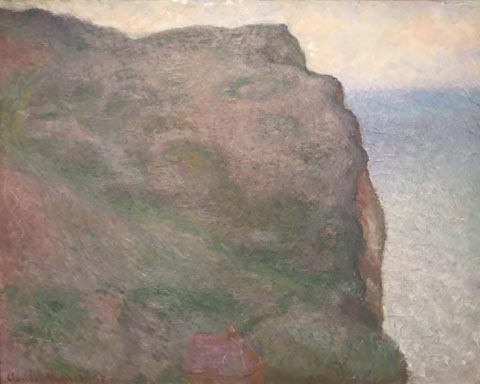 Claude Monet, The Pointe du Petit Ailly in Gray Weather, 1897 The Kreeger Museum, Washington, DC |
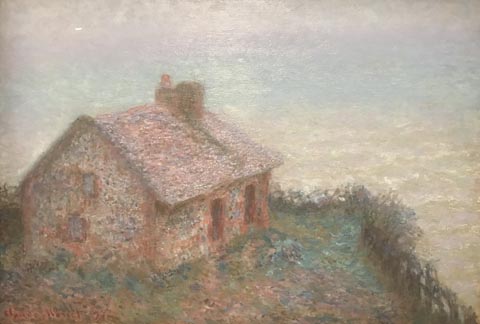 Claude Monet, The Coastguard's Cabin, 1897 Private Collection |
| Southern Light, Bordighera, Antibes, and Venice ... from several trips to Italy, | |
 Claude Monet, Villas at Bordighera, 1884 Private Collection |
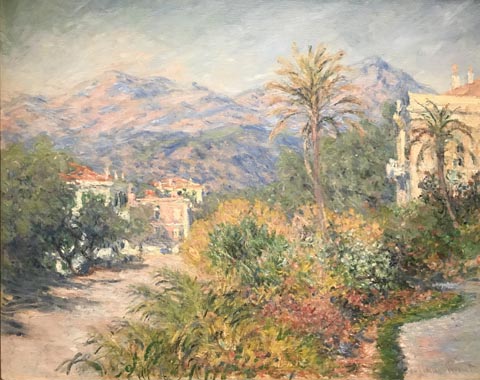 Claude Monet, Strada Romana at Bordighera, 1884 Private Collection |
|
|
 Claude Monet, View of Bordighera, 1884 The Armand Hammer Museum, Los Angeles, CA |
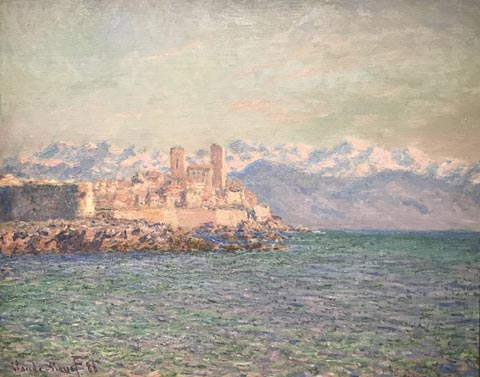 Claude Monet, The Fort of Antibes, 1888 Private Collection |
|
|
 Claude Monet, Atibes Seen from the Salis Gardens, 1888 Private Collection |
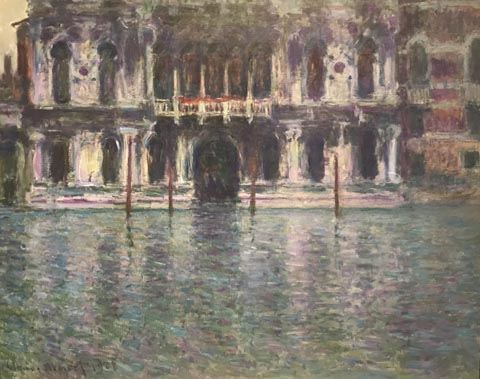 Claude Monet, The Palazzo Contarini, 1908 Privatae Collection |
|
|
 Claude Monet, The Doge's Palace, 1908 Brooklyn Museum, New York, NY |
 Claude Monet, The Rio della Salute, 1908 Private Collection |
|
British art historian and curator of London's Victoria and Albert Museum, Dr. Rosalind McKevar, discusses Monet's trip to Venice in 1908, including the story of how John Singer Sargent introduced Monet to one of his patrons who owned a palatal home in Venice where the Monets stayed. |
|
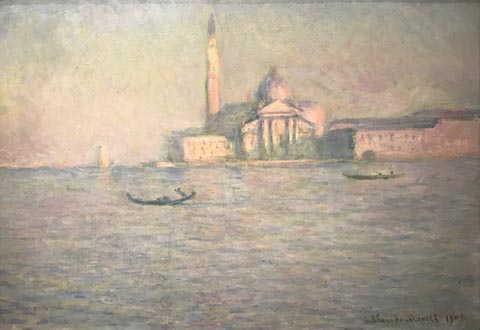 Claude Monet, The Church of San Giorgio Maggiore, Venice, Venice, Italy, 1908 Indianapolis Museum of Art , Newfields, IN |
 Claude Monet, The Palazzo Ducale, 1908 Private Collection |
| The Colors of Fog, London | |
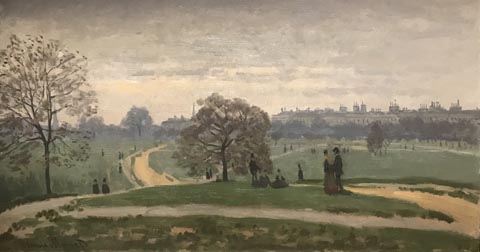 Claude Monet, Hyde Park, London, c1871 Rhode Island School of Design Museum, Providence, RI |
|
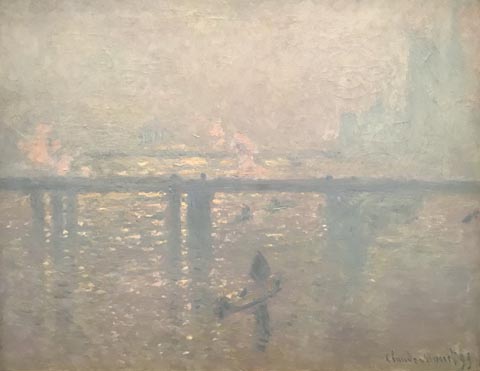 Claude Monet, Charing Cross Bridge in Fog, 1899 Thyssen-Bornemisza Museum, Madrid, Spain |
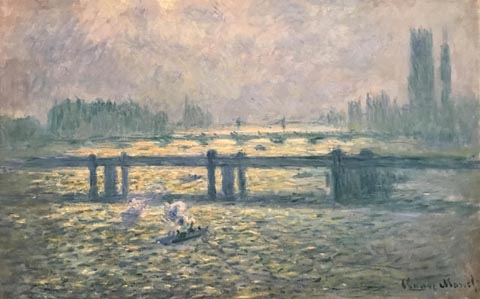 Claude Monet, Charing Cross Bridge, Reflections on the Thames, 1899-1904 The Baltimore Museum of Art, Baltimore, MD |
|
|
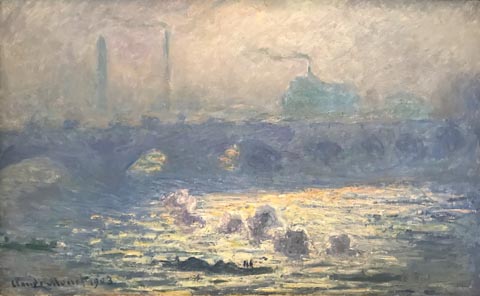 Claude Monet, Waterloo Bridge, 1903 Lowe Art Museum, University of Miami, Miami, FL |
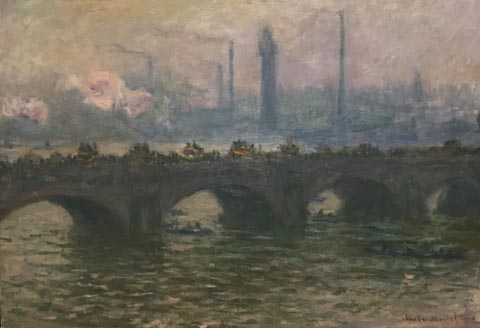 Claude Monet, Waterloo Bridge, 1903 Claude Monet, Waterloo Bridge, 1903Worcester Art Museum, Worcester, MA |
| A Personal Place; Giverny | |
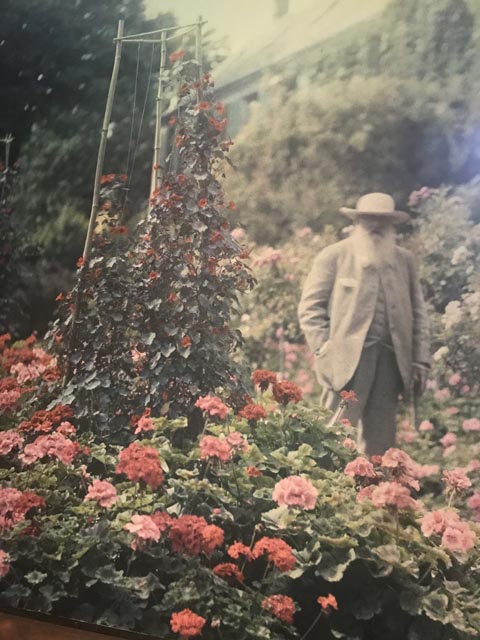 Claude Monet in a white hat with roses by his home at Giverny |
|
 Claude Monet, Houses on the Old Bridge at Vernon, c1883 New Orleans Museum of Art, New Orleans, LA |
|
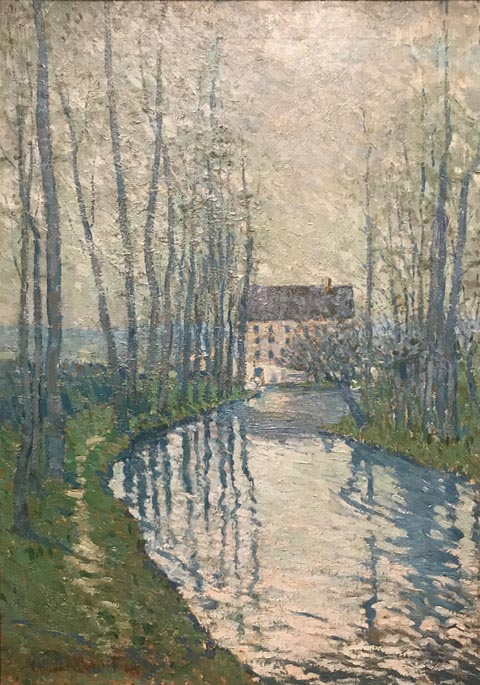 Claude Monet, River and Mill near Giverny, 1885 Collection of Drs. Tobia and Morton Mower, Denver Art Museum, Denver, CO |
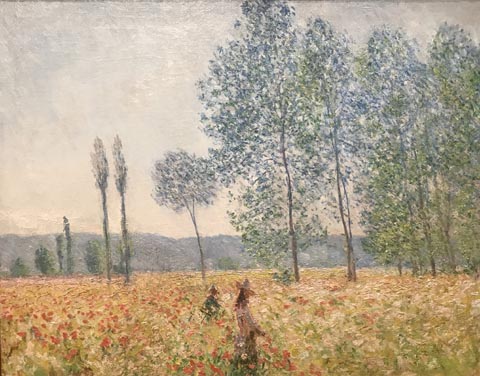 Claude Monet, Under the Poplars, 1887, Private Collection |
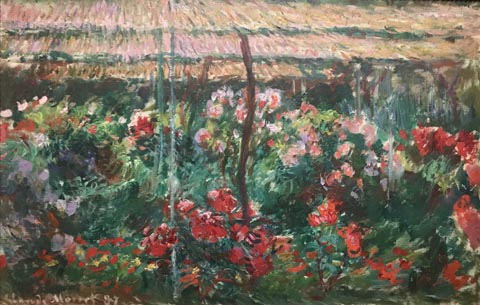 Claude Monet, Peony Garden, 1887 The National Museum of Western Art, Tokyo, Japan |
|
|
|
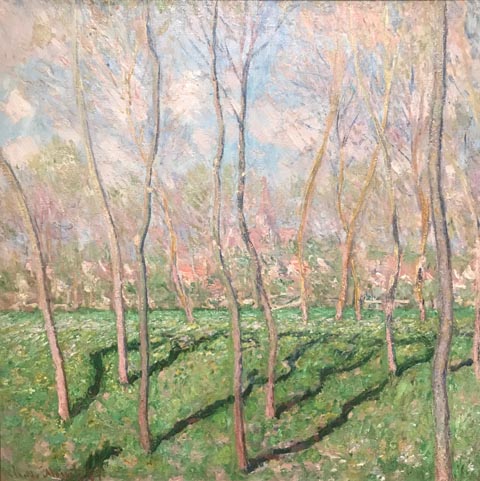 Claude Monet, View of Bennecourt, 1887 Columbus Museum of Art, Columbus, OH |
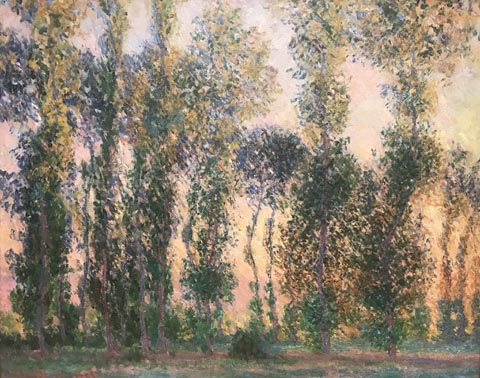 Claude Monet, Poplars at Giverny, 1887 Private Collection |
 Claude Monet, Oak Field, 1890 Samuel P. Harn Museum of Art, University of Florida, Gainsville, FL |
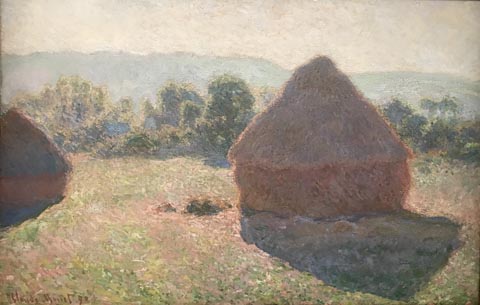 Claude Monet, Haystacks, Midday, 1890 National Gallery of Australia, Canberra, Australia |
|
|
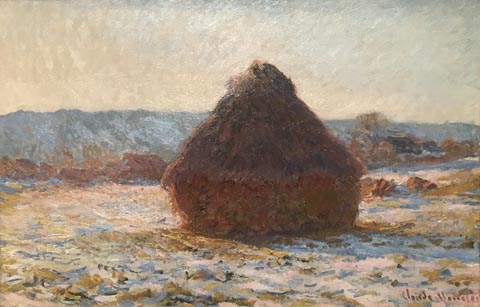 Claude Monet, Grainstack in the Sunlight, Snow Effect, 1891 Private Collection |
 Claude Monet, Grainstacks, Snow Effect, 1891 Shelbourn Museum, Shelbourne, VT |
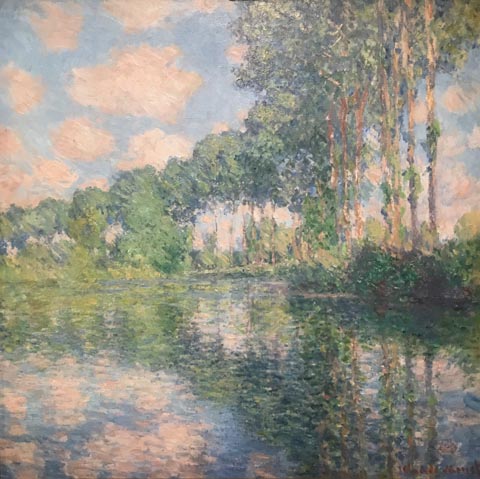 Claude Monet, Poplars on the Epte, 1891 National Galleries of Scotland, Edinburgh, Scotland |
Conventional wisdom would require Monet to paint something significant for a series. But Monet wanted to explore the colors and textures of a different structure, the grainstacks commonly found around his home in the late 19th century. |
| The Seine at Giverny | |
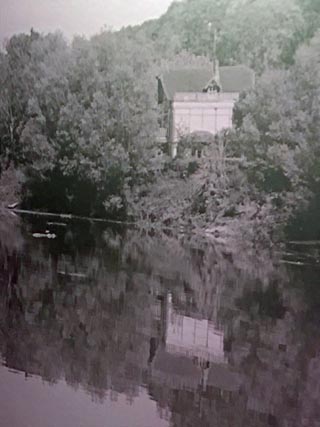 Reflections in the Seine near Giverny |
|
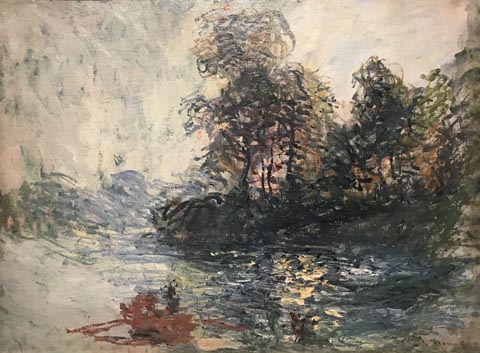 Claude Monet, The River, 1881 Private Collection |
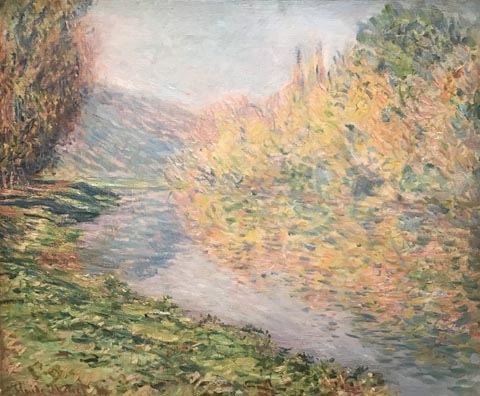 Claude Monet, Autumn at Jeufosse, 1884 Private Collection |
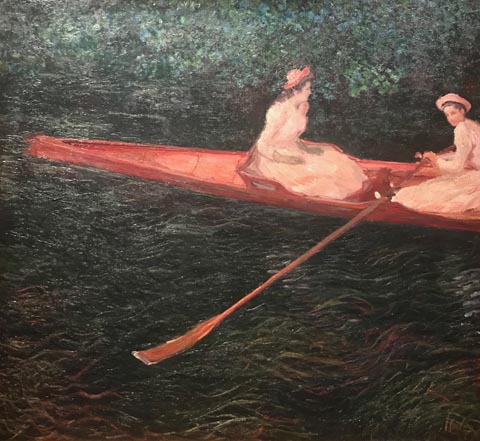 Claude Monet, The Canoe on the Epte, c1890 Museo de Arte de Sao Paulo Assis Chateaubriand, Sao Paulo, Brazil |
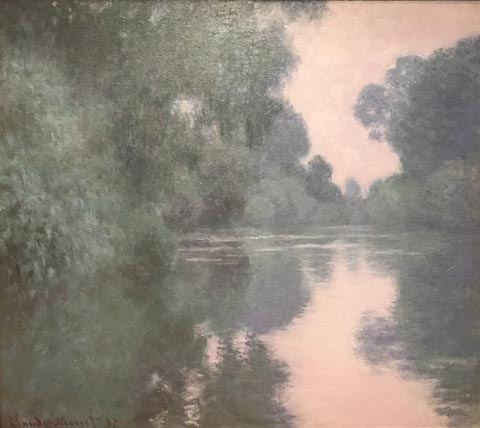 Claude Monet, Morning on the Seine near Giverny, 1897 Museum of Fine Arts, Boston, Boston, MA |
|
|
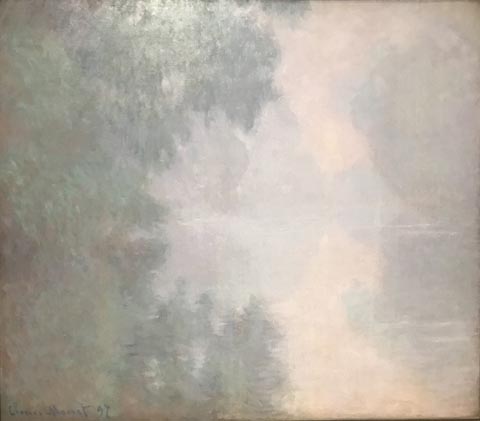 Claude Monet, Morning on the Seine, Giverny, 1897 Mead Art Museum, Amherst College, Amherst, MA |
 Claude Monet, The Seine at Giverny, 1897 Columbia Museum of Art, Columbia, SC |
| A Man-Made Paradise; Monet's Waterlily Pond | |
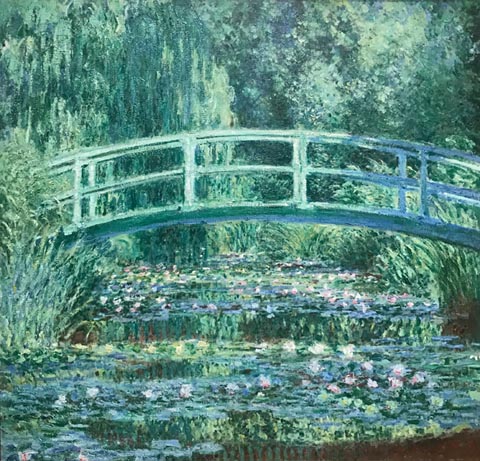 Claude Monet, Water-lilies and Japanese Bridge, 1899 Princeton University Art Museum, Princeton, NJ |
 Claude Monet in 1904 at age 65 by his beloved lily pond at Giverny |
|
|
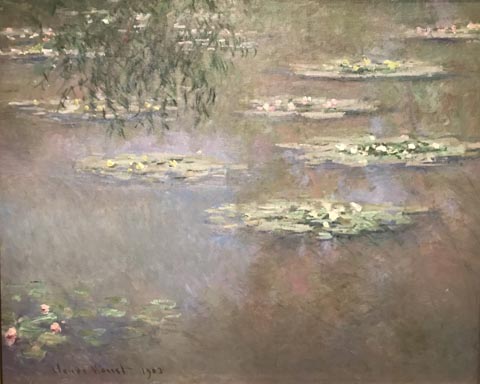 Claude Monet, Water-Lilies, 1903 The Dayton Art Institute, Dayton, OH |
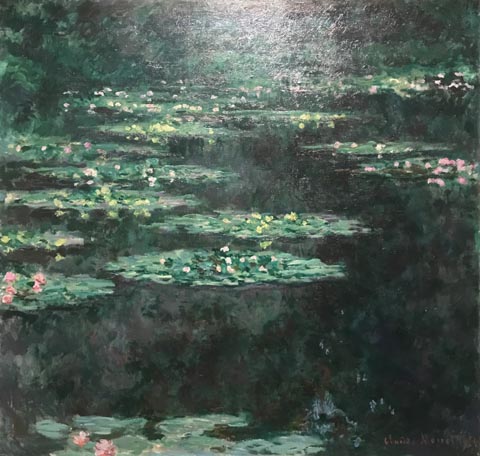 Claude Monet, Water-Lilies, 1904 Musee d'art moderne Andre Malraux, Le Havre, France |
|
|
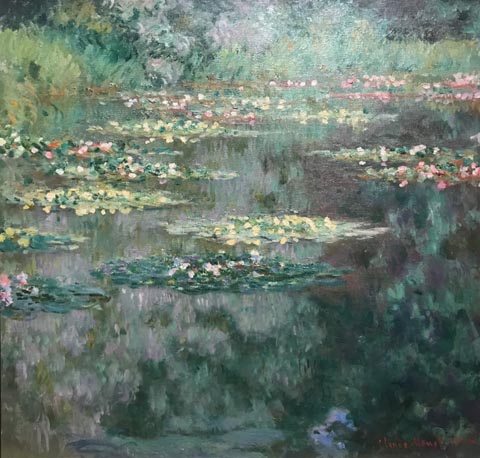 Claude Monet, The Water Lily Pond, 1904 Denver Art Museum, Denver, CO |
 Claude Monet, Water Lilies, 1907 The Museum of Fine Arts, Houston, Houston, TX |
 Claude Monet, Water-Lilies, 1908 Dallas Museum of Art, Dallas, TX |
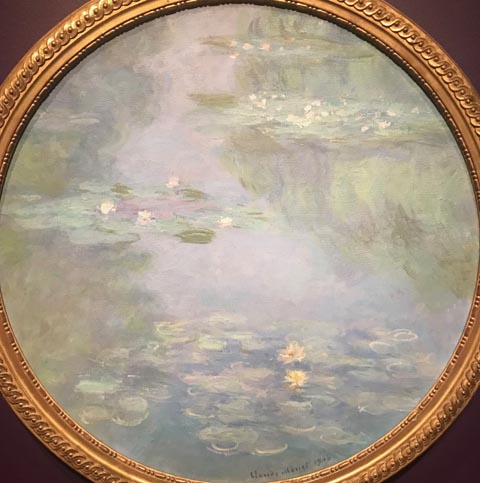 Claude Monet, Water-Lilies, 1908 Musee de Vernon, Vernon, France |
|
On view at the Denver Art Museum, brief footage of Claude Monet painting beside his beloved lily pond at Giverny during his late years. |
|
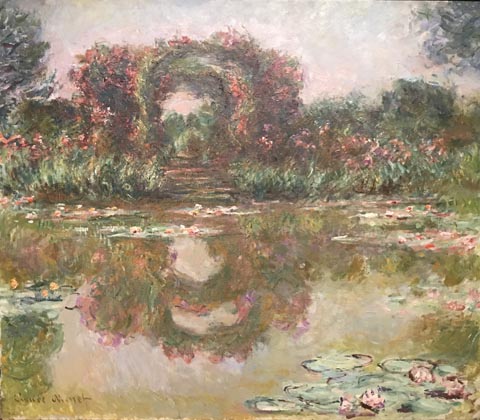 Claude Monet, Rose-Arches at Giverny, 1913 Private collection, Asia |
 Claude Monet, Water-Lilies, 1914-15 Portland Art Museum, Portland, OR |
|
|
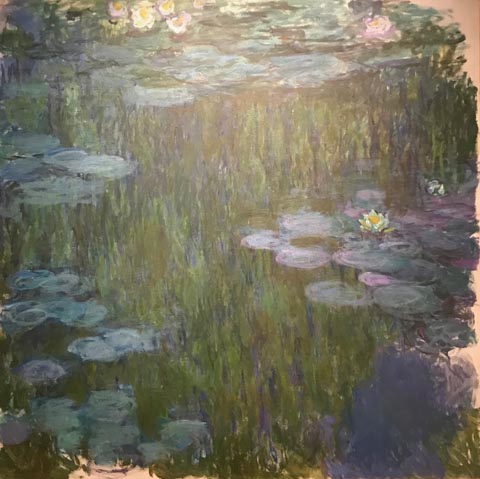 Claude Monet, Water Lilies, 1914-17 Private Collection |
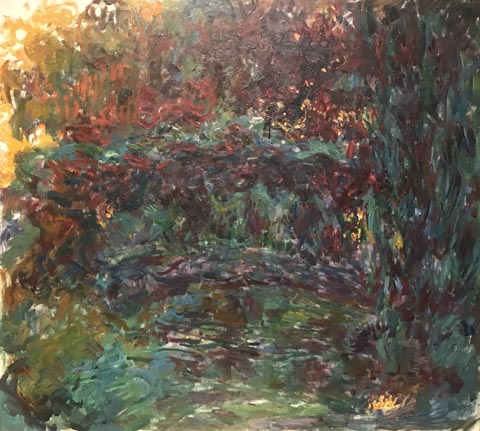 Claude Monet, The Japanese Bridge, 1918-24 Musee Marmottan Monet, Paris, France |
|
|
 Claude Monet, Corner of the Lily Pond, 1918-19 Private Collection |
 Claude Monet, The Japanese Bridge, 1918-24 Onyx Art Collection |
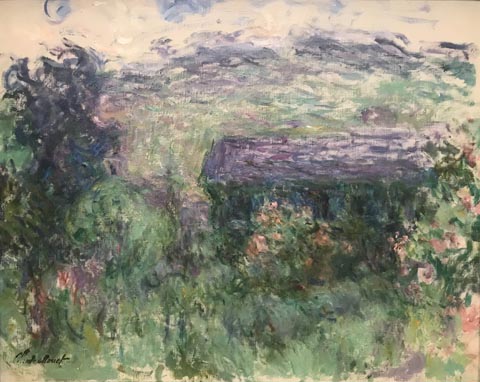 Claude Monet, The House Seen through the Roses, 1925-26 Stedelijk Museum, Amsterdam, The Netherlands |
|
| "Claude Monet: The Truth of Nature" at the Denver Art Museum | |
|
|
|
Claude Monet, The Truth of Nature at the Denver Art Museum |
| Gallery Notes ... | Linda's paintings are on view and available this holiday season at three venues and at her Atelier One Studio in Graton by appointment LindaSorensenPaintings.com | 707-875-2911 In Graton at the Graton Gallery on Graton Road ... Guest artist, Dec 17 - Jan 19, reception, Dec 21, 2 - 5 pm In Santa Rosa at Corrick's Stationary on 4th Street Corricks Art Trails Gallery ... Autumn's Bounty ... thru Dec 31. In Sebastopol, Sebastopol Center for the Arts Member Show ... now thru Jan 5 |
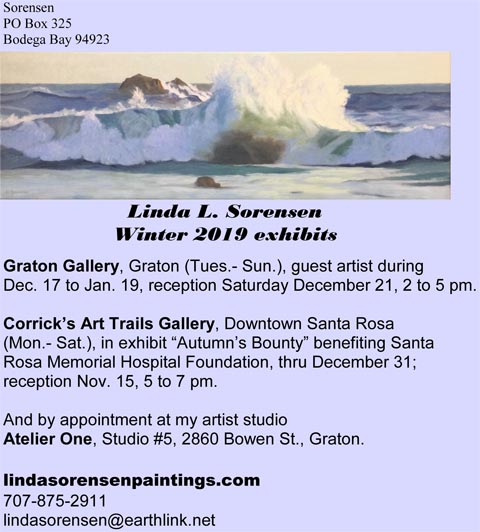  |
|
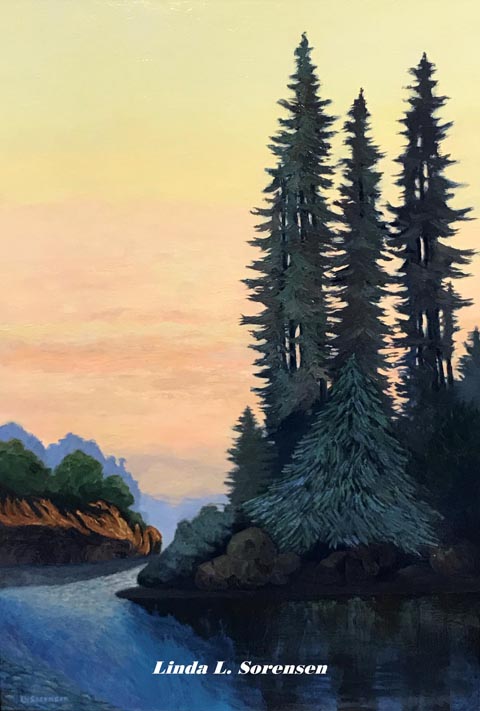 Riversong 36 x 24 |
|
| Linda Sorensen with Keven Brown at Corrick's, Downtown Santa Rosa, in front of paintings included in the "Autumn's Bounty" special exhibit, now through year's end |
| Museum shows in your future ... | ||
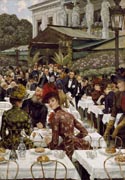 |
Now Showing ... Oct 12 at San Francisco's Legion of Honor James Tissot: Fashion and Faith Legion of Honor Now through Feb 9 |
 December Newsletter 2019 James Tissot: Fashion and Faith at SF's Legion of Honor |
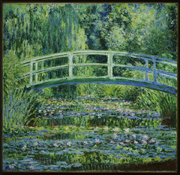 |
Now showing ... in Denver, CO Claude Monet: The Truth of Nature Major lenders include the Musée d'Orsay, Paris; Musée Marmottan Monet, Paris; Museum of Fine Arts, Boston; The Art Institute of Chicago; and the Metropolitan Museum of Art, New York. Denver Art Museum Now through Feb 2, 2020 |
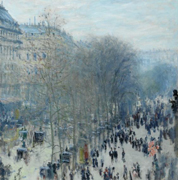 |
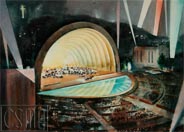 |
Now showing ... in Orange, CA Los Angeles Area Scene Paintings from the Hilbert Collection, A Fine Romance: Images of Love in Classic American Illistration Now through - April 18, 2020 Hilbert Museum Hilbert Museum of California Art at Chapman University, 167 N. Atchison Street, Orange, CA 92866 Located across the street from the Orange Metrolink Train Station |
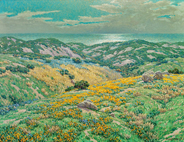 |
|
| What's showing in Bodega Bay? | ||
 |
Bodega Bay Heritage Gallery by appointment in Graton or Bodega Bay http://www.BodegaBayHeritageGallery.com | Call or Text 707-875-2911 email: Art@BodegaBayHeritageGallery.com |
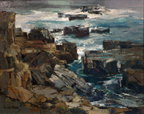 "Composed by Ocean" Joshua Meador |
 Ren Brown |
The Ren Brown Collection 1781 Coast Highway One, Bodega Bay, 94923 707-875-2922 | rbc4art@renbrown.com http://www.renbrown.com | Back to the Top |
 |
Bodega Bay's Jean Warren Watercolors |
||
| What's showing nearby? in Sonoma, Napa & Marin Counties |
||
 |
IN SEBASTOPOL, Sebastopol Center for the Arts home of Sonoma County's Art @ the Source and Art Trails 282 S. High Street, Sebastopol, CA 95472 707.829.4797 Hours: Tue - Fri 10am - 4pm, Sat & Sun 1 - 4pm |
|
 Corrick's Keven Brown |
IN SANTA ROSA Corrick's Art Trails Gallery | http://www.corricks.com/arttrailsgallery 637 Fourth Street, Santa Rosa, CA 95401 | Contact:: http://www.corricks.com/contact-us Corrick's has been a Santa Rosa Treasure since 1915, a downtown stationery store serving the community's "cultural hub." Corrick's has long supported local artists with its impressive "ART TRAILS GALLERY," including paintings by Linda Sorensen. Corricks offers a number of originals by famed Santa Rosa artist, Maurice Lapp ... (see our August 2017 article) located on Fourth Street, steps away from Santa Rosa's revitalized town square and Fourth Street's Russian River Brewery |
 |
 Dennis Calabi |
IN SANTA ROSA Calabi Gallery | http://www.calabigallery.com We are located at 456 Tenth Street in Santa Rosa. Contact us with any questions at (707) 781-7070 or info@calabigallery.com 456 Tenth Street, Santa Rosa, CA 95401 | email: info@calabigallery.com | 707-781-7070 Famed master conservator Dennis Calabi brings his rare knowledge and experience to present a tasteful and eclectic array of primarily 20th century artwork. http://www.calabigallery.com | Back to the Top |
 Easton, Crustacean Dancing Dream, American Alabaster |
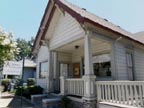 |
IN Santa Rosa The Annex Galleries specializing in 19th, 20th, and 21st century American and European fine prints The Annex Galleries is a member of the International Fine Print Dealers Association (IFPDA). http://www.AnnexGalleries.com | Back to the Top |
|
 |
IN GRATON Graton Gallery |
|
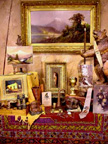 |
IN DUNCANS MILLS Christopher Queen Galleries 3 miles east of Hwy 1 on Hwy 116 on the Russian River http://www.christopherqueengallery.com |707-865-1318| Back to the Top |
|
 |
IN Healdsburg Paul Mahder Gallery http://www.paulmahdergallery.com (707) 473-9150 | Info@paulmahdergallery.com 222 Mill Healdsburg Avenue, Healdsburg, CA 95448 | Open Weds - Mon, 10-6, Sundays, 10-5 |
|
 |
IN Healdsburg Hammerfriar Gallery http://www.hammerfriar.com (707) 473-9600 132 Mill Street, Healdsburg, CA 95448 | Open Tues - Fri 10 to 6, Sat 10 - 5, Sun 12 - 4 |
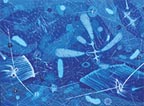 |
 |
|
 |
| Links to current museum exhibits relevant to Early California Art | |||
| The Greater Bay Area | |||
| The Walt Disney Family Museum This museum tells Walt's story from the early days. (on the Parade Grounds) 104 Montgomery Street, The Presidio of San Francisco, CA 94129 -- view location on Google Maps -- |
 |
San Francisco de Young Museum Permanent Collection |
 |
| San Francisco California Historical Society |
 |
San Francisco Legion of Honor James Tissot: Fashion and Faith through Feb 9 -Permanent European and Impressionist Paintings |
 |
| San Francisco Contemporary Jewish Museum |
 |
Oakland Oakland Museum of California -- ongoing Gallery of California Art -showcasing over 800 works from the OMCA's collection |
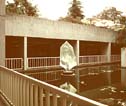 |
San Francisco |
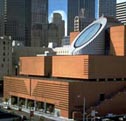 |
 |
|
| Santa Rosa Charles M. Schultz Museum |
 |
 |
|
| Sonoma Mission San Francisco de Solano Museum featuring the famed watercolor paintings of the California Missions by Christian Jorgensen |
 |
Sonoma Sonoma Valley Museum of Art 551 Broadway, Sonoma CA (707) 939-7862 |
 |
| Ukiah Grace Hudson Museum http://www.gracehudsonmuseum.org |
 |
Bolinas |
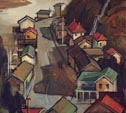 |
| Walnut Creek The Bedford Gallery, Lesher Center for the Arts |
 |
San Jose San Jose Museum of Art approximately 2,000 20th & 21st century artworks including paintings, sculpture, new media, photography, drawings, prints, and artist books. |
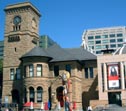 |
| Monterey Monterey Museum of Art Ongoing exhibitions ... Museums Permanent Collection including William Ritschel, Armin Hansen and E. Charlton Fortune http://www.montereyart.org |
 |
Palo Alto Cantor Art Center at Stanford University |
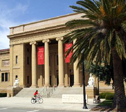 |
Monterey |
 |
Sacramento Crocker Art Museum NEW TWO-YEAR LONG EXHIBIT COMING ... Jan 26 - May 17 Granville Redmond, The Eloquent Palette & their marvelous Permanent Collection |
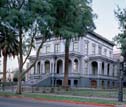 |
| Sacramento Capitol Museum Governor's Portrait Gallery Permanent Exhibits (including one of our galllery's favorite artists, Robert Rishell's portrait of Gov. Ronald Reagan |
 |
Stockton's Treasure! The Haggin Museum -Largest exhibition of Albert Beirstadt paintings anywhere, plus the works of Joseph Christian Leyendecker, Norman Rockwell's mentor. see our Newsletter article, April 2011 |
 |
| Southern California (and Arizona) | |||
| Los Angeles Los Angeles Museum of Art Art of the Americas, Level 3: Artworks of paintings and sculptures from the colonial period to World War II— a survey of of art and culture & "Levitated Mass" |
 |
Irvine (now part of UC-Irvine) The Irvine Museum El Camino del Oro, Sept 14 - Jan 11 Paintings of the California Missions era by many of California's noted artists |
 |
| Santa Barbara The Santa Barbara Museum of Art |
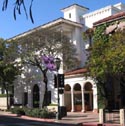 |
Orange LA Area Scene Paintings from the Hilbert Collection, A Fine Romance: Images of Love in Classic American Illistration through - April 18, 2020 Hilbert Museum, Chapman University |
 |
| Pasaden Norton Simon Museum -an Impressive Permanent collection, European impressionist and post impressionist paintings See our newsletter from March 2014 |
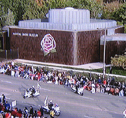 |
San Marino (near Pasadena) The Huntington Library American Art Collection Paintings by John Singer Sargent, Edward Hopper, Robert Henri, Albert Bierstadt, Thomas Moran, William Keith, Mary Cassatt, Thomas Hart Benton and many more. |
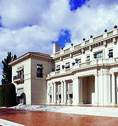 |
| San Diego San Diego Museum of Art Permanent Collection |
 |
Palm Springs |
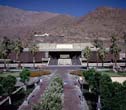 |
| Phoenix, AZ Phoenix Art Museum an excellent sampling of Artists of the American West |
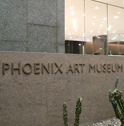 |
Los Angeles California African American Art Museum adjacent to the LA Coliseum (see our newsletter articleof their Ernie Barne's Exhibition September 2019) |
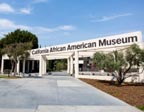 |
| & Beyond | |||
| Honolulu, HI Honolulu Museum (see our Newsletter article from February, 2015) |
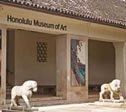 |
Kamuela, HI (Big Island) Issacs Art Center 65-1268 Kawaihae Road Kamuela, HI 96743 (See our Dec '16 article "Hawaii's Paul Gauguin," modernist Madge Tennent, 1889-1972) |
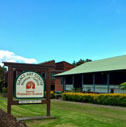 |
| Seattle, WA Seattle Art Museum ( see our article Mar 2018 French and American Paintings ) |
 |
Portland, OR Portland Art Museum Permanent Collection: American Art |
 |
| Washington D.C. The Renwick Gallery Permanent ... Grand Salon Paintings from the Smithsonian American Art Museum |
 |
Chicago, IL Art Institute of Chicago Permanent collection: the Impressionists |
 |
| Cedar Rapids, IA The Cedar Rapids Museum of Art Grant Wood: In Focus is an ongoing permanent collection exhibition. |
 |
Bentonville, AR |
 |
| Washington D.C. The National Gallery Permanent collection American Paintings |
 |
Philadelphia , PA The Philadelphia Museum of Art |
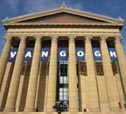 |
| Philadelphia , PA Barnes Foundation, Philadelphia Campus |
 |
Brooklyn, NY The Brooklyn Museum American Art Permanent Collection |
 |
| New York , NY The Whitney Museum of American Art The largest selection of works by Edward Hopper |
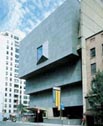 |
New York , NY Metropolitan Museum of Art Its extensive collection of American Art |
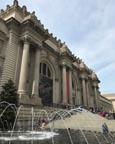 |
| Detroit, MI Detroit Institute of Arts American Art Permanent Collection |
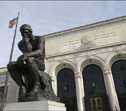 |
Ottawa, Ontario National Gallery of Canada |
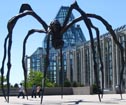 |
| Denver, CO Denver Art Museum Monet, the Truth of Nature through Feb 2 |
 |
|
|
| By appointment only or online ... email or call ... Art@BodegaBayHeritageGallery.com / 707-875-2911 | ||
|
|
|
|